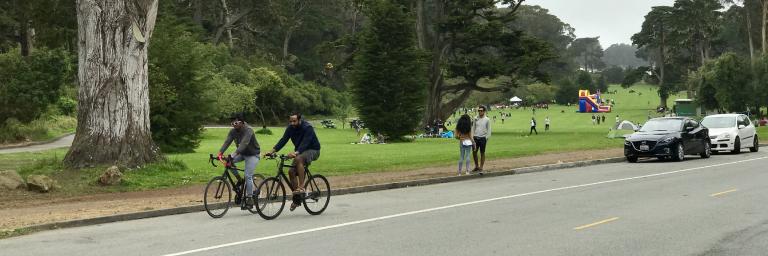A green space used by 13 million people each year, Golden Gate Park is both a place of recreation and travel. In support of Mayor Ed Lee’s Vision Zero Executive Directive, SFMTA and the San Francisco Recreation and Parks Department (SFRPD) are partnering on the Golden Gate Park Traffic Safety Project, which aims to reduce unsafe vehicle speeds and better manage traffic in the park.
In November 2016, SFMTA in partnership with SFRPD installed nine speed humps and one raised crosswalk on John F. Kennedy Drive (west of Transverse Drive) as a near-term measure to address speeding. Since late 2016, staff have solicited feedback from stakeholders to inform the development of another set of safety improvement projects for the entire park that will be constructed starting in 2018.
View project proposals, summaries of public feedback, and other project materials under the 'Related Reports & Documents' header on this page. To stay informed about this project, please share your email with us under the 'Receive Updates' header.
- Completed
Where We Are:
In November 2016, the SFMTA installed nine speed humps and one raised crosswalk on John F. Kennedy Drive (west of Transverse Drive) as a near-term measure to address observed speeding. Following this, in December 2016, SFMTA and SFRPD held an open house in Golden Gate Park to provide the public with information about the project, collect feedback on priorities, and gather information about specific locations for further study. This feedback, in addition to ongoing data collection and an online survey, was used to develop proposals for safety improvements and traffic changes on park roads to be constructed in late 2017 and early 2018.
These proposed projects were presented at Sunday Streets in Golden Gate Park on June 11th, where feedback from the public was solicited; additional feedback was collected through an online survey conducted over the summer. The project team is currently refining these projects (the details and locations of which are available for view under the 'Related Reports & Documents' header) for implementation beginning later this year.
If you would like to be involved, please share your email under the 'Receive Updates' header.
Vision Zero:
John F. Kennedy (JFK) Drive is on the city’s Vision Zero High Injury Network – the 13% of city streets that account for 75% of severe and fatal traffic collisions.
Every year, approximately 30 people are killed and 200 more are seriously injured while travelling on city streets. As a county, San Francisco ranks among the highest (worst) for traffic deaths and injuries in California. These deaths and injuries are unacceptable and preventable, and San Francisco is committed to eliminating them.
Vision Zero aims to eliminate all traffic deaths in San Francisco. By adopting the Vision Zero policy in 2014, the San Francisco is working to build better and safer streets, educate the public on traffic safety, enforce traffic laws, and prioritize resources to implement effective initiatives that save lives.
Speed Humps:
Nine speed humps and one raised crosswalk were built on JFK Drive between Transverse Drive and the Great Highway in late 2016.
Speeding is a threat to everyone using the park, whether for recreation or to reach their destination. Research has shown that lowering speeds – from 40 mph to 20 mph, for example – dramatically improves the likelihood someone will survive a collision. If you’re hit by someone driving a car at 40 mph, you only have a 10 percent chance of survival; at 20 mph, the chance of survival is 90 percent. Our study of travel behavior along JFK Drive shows that drivers are typically going 7-9 mph above the speed limit in the daytime, and even faster at night. Speed humps are proven to be effective at reducing vehicle speeds, reducing the number of vehicles travelling 30 mph by 80 percent.
Timeline:
- August 4, 2016: Mayor Lee issues an Executive Directive on pedestrian and bicycle safety
- November 2016: Speed humps constructed on JFK Drive west of Transverse Drive
- December 3, 2016: Community open house
- December 2016 - March 2017: Review data and public feedback; draft near-term proposals
- Spring - Summer 2017: Additional outreach; detailed design for near-term improvements
- June 11, 2017: Outdoor open house at Sunday Streets in Golden Gate Park
- Late 2017 - early 2018: Implementation of additional near-term interventions
- 2018+: Additional outreach, study, and analysis for any potential larger-scale projects
